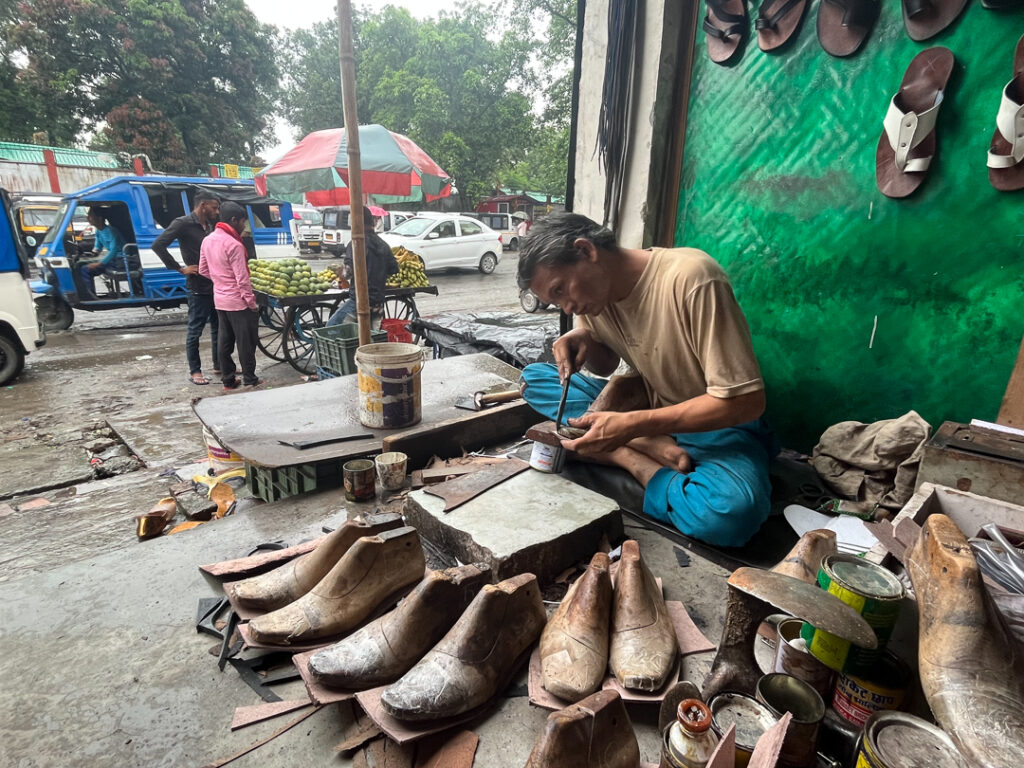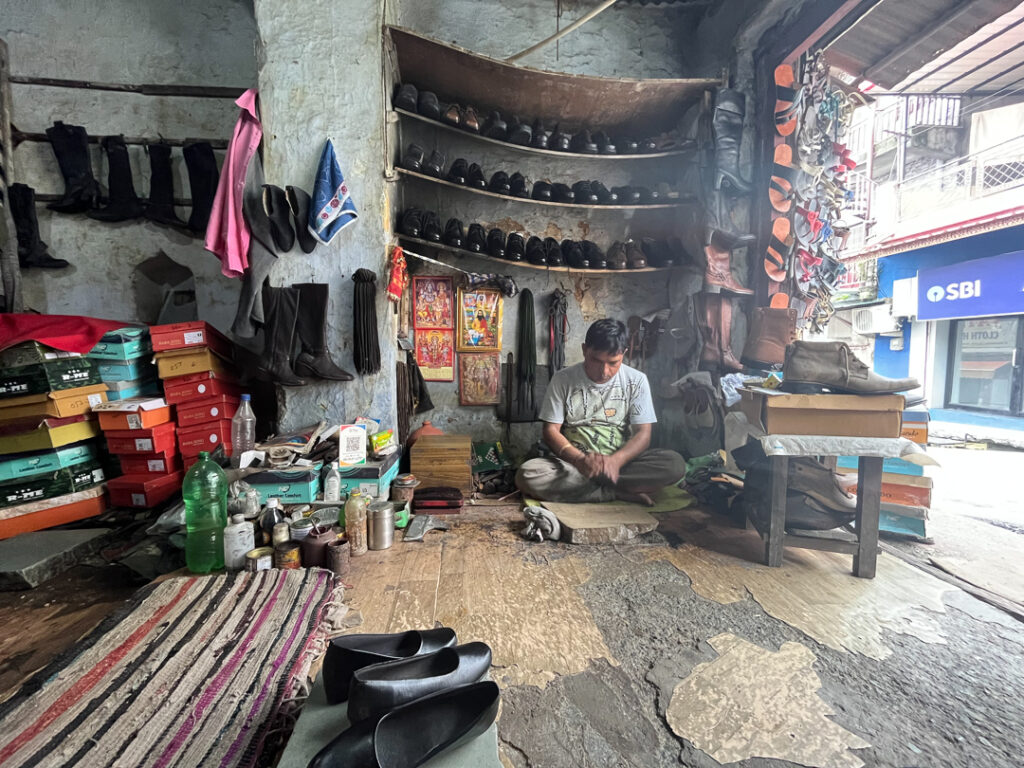LOkesh Ghai honours the shoemakers of his neighbour and argues for the continuing value.
It is a lesser-known fact that the history of shoemakers and their advent in the Dehradun Valley is linked to the defence. There are three locations in Dehradun where the defence has been based: Clement town, Ghari Cantt and IMA the Indian Military Training Institute, next to my house. In the early mornings, I wake up to the sound of the band, the young men in training marching past in their shoes.
I interviewed over thirty shoemakers in Dehradun and Mussoorie. Most told me that their ancestors migrated from Central India in 1857. Their history was not written. They heard from their ancestors of being bullied by the upper caste which left them no choice but to flee as a community via Punjab.
I spent a few hours at each of the shoemaker’s studio shops in various neighbourhoods of Dehradun. One such street has two makers, Hemant and Jagdish Prasad. The two brothers were part of Clement-town’s ecosystem. The younger had established his studio-shop two decades ago followed by his older brother a decade later. The younger on the main road just before turning to the Buddha temple and the older in the parallel back lane.
Both brothers had learned the craft from their father who made shoes for the defence. The defence sector brings a sizable consumer base. It was their specific footwear needs that led the shoemakers to settle in this location. In an interview that lasted three hours, veteran shoemaker Deepchand Gangoli said that part of the soldiers in training first-morning jobs was checking the spike of their shoes. If even one nail is out of place, their foot would get injured. Laces had to be tied in a certain manner. Almost half an hour of his (soldiers in training) time each day was dedicated to the upkeep, cleaning and polishing in stages.
He continued,
“When I was just eight years old, we would set off in the morning with a shoe polish box. Now, people don’t have time to even lace their shoes. Polishing is a ritual of the old world. My grandfather used to hand make shoes for the British Army and post-independence for the Indian Army”.
Deepchand ji presented me with a photo dated 1936 of his late grandfathers with shoes handmade by him for the British soldiers. He recalls vivid memories, “post-independence years when I was a kid, I was surprised to find elderly English Ladies (visiting India) touching the feet of a senior shoemaker from our community. I later gathered that he was like an extended family member”.
In those days the shoemakers would visit their client’s family home. Like a family doctor, there was a family shoemaker. The foot measurements were taken at the family house. In the next visit, a trial was given, and adjustments were made before another visit for delivery. The shoemakers would get a good tip for the making. Sometimes Italian shoe design was brought by the Britishers as a reference. The Indian artist could make an even better version with adjustments. Those times were prosperous for the shoemakers.
In a recent article, I read that “distance” and “quantity” is what makes luxury. Shoes were not merely a luxury. In the mountains, having strong shoes was almost a metaphor for how long you could go ahead in life.
Almost all shoemakers I spoke to during my course of field research spoke of two names: the late Bhagwan Das and Lu Hong Kong. All shoemakers in Dispenser Road, Dehradun mentioned Bhagwan’s name as the person whom they learned from. Now two of his sons carry the legacy. Manoj ji a retired Indian army officer told me that in his youth he had to save a sizable part of his salary, some 450 rupees for a pair of handmade shoes. They were such good shoes. “Earlier the drapers were sent to England to learn tailoring, I got my clothes stitched from a descendant of one such family. Unfortunately, they are no more, and I have stopped acquiring new clothes. Nothing fits the same as what the tailors and shoemakers made back then”. Now people buy ready-made branded shoes and clothes that last a short time and then they just throw them away.
What about Lu Hong Kong? Why does everyone remember him? I was told that he was a master. The retired officer had told me that he could not afford what Lu Hong Kong made. His craftsmanship was different from others. And being of his kind in Dehradun, he attracted attention. Another local added that his stitching was distinct and thus the shoe looked different. I spoke to shopkeepers opposite Ashtley Hall where his studio shop was once located. The family left a few years ago, perhaps to Mumbai from Dehradun.
Chinese migrants to India decades ago were known as dentists or shoemakers in several towns. They are two very different professions with common distinct skills: both involve “stitching”. As a kid, I went to a Chinese dentist. She was very good with implants and I recall the needle and threads at the clinic.
According to a senior local, Lu Hong Kong was one of the early migrants whose family most likely had fled to India when mainland China started encroaching on Formosa (present-day Taiwan), just like their Indian counterparts, who had fled from central India to find a secure life in making shoes.
For years the community of shoemakers handmade bespoke boots, sandals, chappals and shoes for the army, school children and common citizens. Their identity is fast reducing to menial menders. Post GST (Goods and Services Tax) and COVID, the majority of shoemakers have lost most of their business. Out of some four hundred families in the community, many are unemployed, with one of the best shoemakers by the footpath now mending umbrellas and chappals to make ends meet.
While the next generation is assertive about not entering this trade, could there be a better future for the existing ones? The state of Uttarakhand heavily relies on tourism for earning. Could the heritage shoemakers have a role? While the shoemakers in Landour in Mussoorie are somewhat popular amongst tourists, this could be one of the paths forward for those in Dehradun. It is time that the capital city of Dehradun included small-scale craftspeople in their smart city agenda. As citizens or tourists, we take pride in and support what is locally made. So next time you are in Dehradun or Mussoorie, acquire a handmade Roman chappal, a classic Oxford or a Summer sandal.
Find out more about the shoemakers of Dehradun Valley at an exhibition from 19 July 2024 at Café Laata, Dehradun and public engagement events scheduled for mid-July 2024. You are welcome to reach out to the author with your own shoemaker’s narrative or to contribute to the shoemaker’s map of Dehradun, Mussoorie and Vikas Nagar being currently built by the author along with his friends. This article is an outcome of an ongoing research grant awarded to the author by IFA . You can follow the project at @shoesheritage.




Comments
An insightful glimpse into the rich tradition of shoemaking in Dehradun, showcasing the skill, dedication, and cultural heritage woven into every stitch. A beautiful ode to the artisans preserving this timeless craft.
A most interesting look into history and the people that make it…
It’s a good one. There were a lot of things i didn’t know. Also, bringing up this precious and now neglected craft sheds light on your observation skills and determination to let people know of the things they are losing under the garb of overly publicised so-called developmental goals. It’s a commendable effort in the direction of mending the city with its lost charm. If we paint all the places with the same buildings and skyscrapers and call it smart, we are unaware of the uniqueness of land and civilization and what comes with it. I would have never thought of shoemakers of dehradun if you hadn’t brought it up. I think here’s where a researcher and an artist succeeds: letting know of the unknown, more so if it was known before.